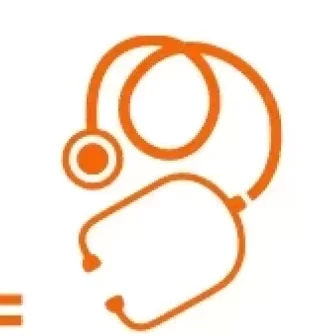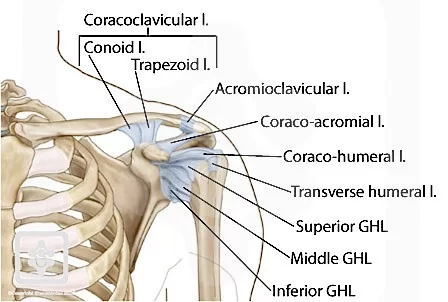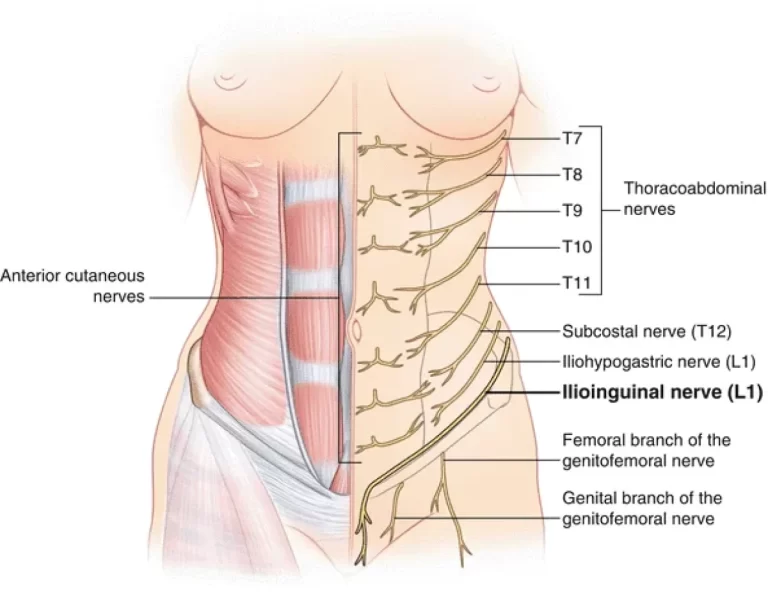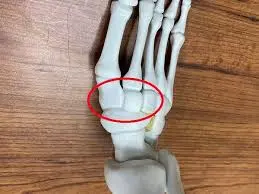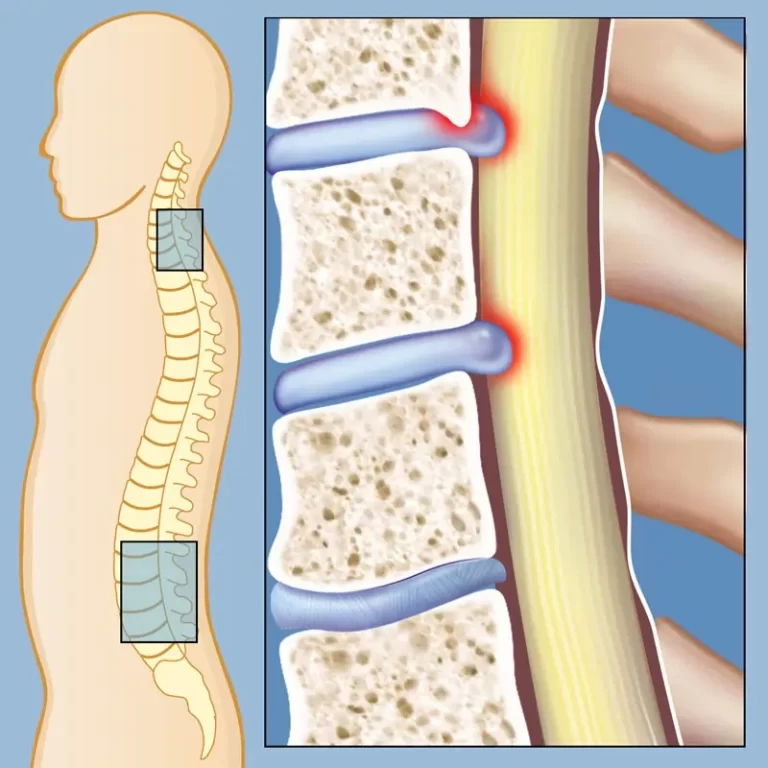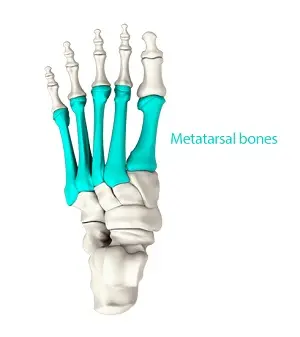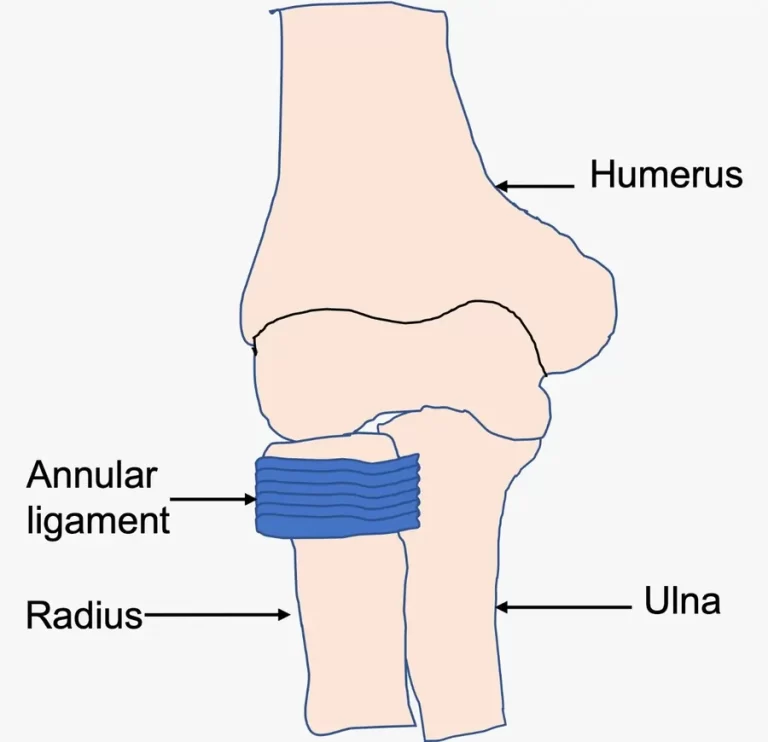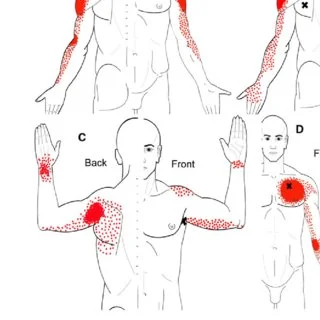Shoulder Ligament
Introduction
Strong bands of connective tissue called shoulder ligaments unite bones, including the humerus, clavicle, and scapula, to stabilize the shoulder joint. They are essential for preserving the integrity of joints and permitting regulated, fluid movement while avoiding dislocations and overuse.
Each shoulder is supported by several ligaments that also keep the bones together, support and reinforce the joint capsules, and prevent dislocation.
Ligaments’ collagen fibres become less elastic and more rigid as we age, becoming straighter rather than wavy. These ligaments connect the scapula (shoulder blade) and humerus (upper arm bone), assisting in maintaining the joint’s position during movement.
Ligaments of the Shoulder Joint
The shoulder joint ligament, a complex structure composed of several ligaments, serves to stabilize the shoulder joint. These ligaments are made up of:
- At the apex of the joint, the superior glenohumeral ligament helps prevent the humerus bone from moving too much upward.
- The middle glenohumeral ligament, located in the center of the humeral joint, keeps it from rotating too much.
- The humerus bone’s excessive downward motion is restricted at the base of the joint by the inferior glenohumeral ligament.
- The ligament that joins the humeral bone to the coracoid process of the scapula stabilizes the joint.
- The transverse humeral ligament prevents the biceps tendon’s long head from dislocating by holding it in place.
- The coracoacromial ligament covers the shoulder joint. It stops the humerus bone from moving too much upward by joining the coracoid process to the acromion process of the scapula.
- The ligament that joins the clavicle bone to the scapula’s acromion process stabilizes it.
- The shoulder socket is surrounded and supported by a ring of cartilage called the glenoid labrum, which is not a ligament.
Functions of the shoulder joint ligament
The shoulder joint ligament supports and facilitates the easy movement of the humerus bone.
Throwing a ball or reaching for something on a high shelf are examples of overhead movements that might cause the humerus bone to rise abnormally upward. The superior glenohumeral ligament prevents this.
For the humerus bone to remain properly positioned during actions such as reaching across the body, the middle glenohumeral ligament helps prevent excessive rotation of the bone.
For the humerus bone to remain stable during weight-bearing tasks like lifting big objects, the inferior glenohumeral ligament assists in avoiding excessive downward movement.
Limiting excessive humeral external rotation is another benefit of this ligament.
The transverse humeral ligament sustains the biceps tendon’s rigidity and stops its long head from moving. For the joint to remain properly aligned during biceps-related activities, this is crucial.
The humerus bone cannot move too much upward because the coracoacromial ligament acts as a roof over the shoulder joint. Additionally, this ligament helps prevent impingement, which can occur when soft tissue structures between bones are compressed during specific motions.
The clavicle bone and the scapula’s acromion process are joined by the acromioclavicular ligament, which stabilises the joint. When performing motions like reaching overhead, this ligament is crucial for preserving the joint’s correct alignment.
The humerus bone fits more tightly due to its structure, which also helps to deepen the socket.
Injuries to the shoulder joint ligament
Injuries to the shoulder joint ligament can be caused by a variety of reasons, such as trauma, overuse, and degenerative changes. The degree of injury can vary from minor sprains to total tears, depending on the ligament’s level of injury.
Trauma to the Superior Glenohumeral Ligament: Shoulder joint instability caused by a superior glenohumeral ligament injury can cause pain and weakness when performing overhead motions.
Middle Glenohumeral Ligament Injury: When reaching across the body, an injury to the middle glenohumeral ligament may result in pain and instability. Athletes who play sports involving repetitive throwing or overhead motions frequently sustain this kind of injury.
Inferior Glenohumeral Ligament Injury: When the shoulder joint becomes unstable due to an injury to the inferior glenohumeral ligament, it can cause pain and weakness when doing weight-bearing tasks like lifting large objects. The humerus bone may dislocate from the socket in extreme circumstances, necessitating prompt medical intervention.
Injury to the Coracohumeral Ligament: When the humerus bone is externally rotated during movement, an injury to the coracohumeral ligament may cause stiffness and weakness in the shoulder joint. Athletes who play sports involving repetitive throwing or overhead motions frequently sustain this kind of injury.
Transverse Humeral Ligament Injury: When the transverse humeral ligament is injured, the biceps tendon may become unstable, causing pain and weakness when the biceps muscle is used. Athletes who play sports involving repetitive overhead motions frequently sustain this kind of injury.
Coracoacromial Ligament Injury: When the coracoacromial ligament is injured, the soft tissue structures in the shoulder joint may be impinged, causing pain and weakness when the arm is raised overhead. This kind of injury is frequently sustained by those who engage in repetitive overhead activities like tossing or painting.
Glenoid Labrum Injury: As the glenoid labrum is injured, the shoulder joint becomes unstable, causing pain and weakness as the arm is raised overhead. This type of injury is frequently sustained by athletes who participate in sports that require much overhead motion.
The shoulder joint may eventually become unstable due to injury to the humerus joint ligament, causing pain and weakness during a variety of motions. These injuries can be treated with physical therapy, rest, and in extreme situations, surgery. If you think you may have a humerus joint ligament injury, you should get medical help right away to stop further injury and encourage healing.
A specific examination of the shoulder joint’s ligaments
Shoulder joint ligament integrity can be evaluated with specific specialized testing. These tests, which are often performed by a physician or physical therapist, involve specific movements or positions that strain the injured ligament. Examples of particular tests for different ligaments in the humerus include the following:
A 90-degree abduction of the arm is performed while the patient is on their back as part of the Superior Glenohumeral Ligament test. The examiner then presses the arm downward while stabilizing the scapula. A patient’s discomfort or anxiety, which could point to a superior glenohumeral ligament injury, indicates a positive test.
Middle Glenohumeral Ligament Test: The patient’s arm is adducted across the body when they are either standing or seated. A patient’s discomfort or anxiety, which could point to a middle glenohumeral ligament injury, indicates a positive test.
Inferior Glenohumeral Ligament Test: The patient lies on their back while their arm is abducted to a 90-degree angle. The examiner applies an anterior force on the humerus after stabilizing the scapula. A patient’s discomfort or anxiety, which could point to an injury to the inferior glenohumeral ligament, indicates a positive test.
Coracohumeral Ligament Test: The patient’s arm is adducted across the body when they are either standing or sitting. Pressure is applied to the arm by the examiner to stabilize the scapula. Pain or anxiety in the patient, which could indicate a coracohumeral ligament injury, is a sign of a positive test.
The transverse humeral ligament test involves the patient standing or sitting with their elbow flexed to 90 degrees. After that, the examiner stabilizes the humerus and delivers an upward push to the forearm. In the event that the test is positive and the patient has discomfort or anxiety, a transverse humeral ligament injury may be suspected.
The patient’s arm is abducted to a 90-degree angle as they sit or stand for the Glenoid Labrum Test. Next, the examiner stabilizes the scapula and presses the arm downward. Shoulder pain or clicking may be indicative of a glenoid labrum injury, a positive test result.
Treatment for the shoulder joint’s ligament
The severity of a shoulder ligament injury determines how it is treated. For more serious injuries, physical therapy or surgery may be required; for less severe ones, rest, ice, and over-the-counter pain relievers may be sufficient.
Conservative treatment methods for shoulder ligament problems may include:
- Rest: To allow the ligament to recover, avoid doing anything that hurts.
- Ice: The affected area may feel less swollen and uncomfortable if ice is applied.
- Compression: To help with edema reduction and support, apply an elastic bandage to the affected area.
- Elevation: Edema is reduced by raising the affected leg above the level of the heart.
- Pain relievers: Ibuprofen and acetaminophen are examples of over-the-counter pain relievers that can help lower inflammation and ease discomfort.
Physical treatment may assist in increasing the range of motion, strength, and flexibility of the affected joint. A physical therapist can use a variety of techniques, such as manual therapy, strengthening exercises, and stretching, to help and improve joint function while reducing discomfort.
In severe ligament injuries, restoration or repair of the torn ligament might require surgery. This may include using a synthetic substance or a transplant from another part of the body to replace a torn ligament.
The severity of the injury and the type of therapy determine how long it takes to recover from shoulder ligament injury. Minor wounds may heal in a few weeks, but more serious wounds may take many months to fully heal. Following the recommended course of therapy and avoiding activities that could worsen the injury are crucial during the healing process.
Rehabilitation of the shoulder joint’s ligaments
For shoulder ligament injuries, physiotherapy treatment may include a combination of exercises, manual therapy, and modalities to help improve joint function, reduce pain, and hasten healing. The following are common physiotherapy approaches for shoulder ligament disorders:
- Range-of-motion exercises: These enhance joint flexibility and mobility. To enhance joint function, a physiotherapist may lead the patient through mild stretches and range-of-motion exercises.
- Strengthening exercises: These workouts help to make the muscles around an injured joint more stable and strong. To help increase joint stability, a physiotherapist could recommend exercises that focus on particular shoulder joint muscles.
- Physical therapy: Manual therapy techniques, such as massage, joint mobilization, and manipulation, can be used to reduce pain and improve joint mobility.
- Modalities: Heat, cold, ultrasound, and electrical stimulation are some of the modalities that may be used to reduce pain and inflammation and promote healing.
- Functional training: A patient’s goals and needs are taken into consideration while performing everyday life activities. In order to improve joint function and reduce the risk of additional injuries, a physiotherapist may work with the patient to develop a customized exercise program that includes functional training.
Patients should follow the treatment plan that their physiotherapist prescribes and attend all of their appointments in order to achieve the best outcomes.
Risk factors for the shoulder joint ligament
- Age: Shoulder injuries and other ligament disorders are more common as we age. This results from the ability of ligaments to weaken and become less flexible over time.
- Sports and physical activity: Playing sports or engaging in activities that require a lot of overhead motions or repetitive motions can raise your risk of shoulder ligament injury.
- Overuse and repetitive strain: These conditions can harm the shoulder joint by putting stress on the ligaments. This is commonly seen in sportsmen who routinely throw or make overhead motions.
- Accidents or trauma: The shoulder ligaments may sustain injuries from forceful collisions, abrupt falls, and other traumatic incidents. Sports, high-impact exercises, and accidents may lead to these injuries.
- Instability and bad posture: The shoulder joint’s stability may be reduced, and the risk of ligament rupture increased if the muscles around it are weak or unbalanced. Furthermore, shoulder instability can be caused by bad posture, such as rounded shoulders or a forward-leaning head.
- Previous injuries: If you’ve had a shoulder injury or a ligament rupture in the past, you’re more likely to get hurt again or develop new ligament problems.
- Anatomical and genetic factors: Due to particular anatomical variations or inherited causes, some individuals may be more prone to ligament injuries. These components could include shallow shoulder sockets, abnormal ligament structure, or joint laxity (looseness).
How to prevent injury to the shoulder joint’s ligaments
The following actions can help prevent injury to the shoulder ligaments:
- Maintain proper posture: Poor posture can place additional strain on the shoulder joint and raise the risk of injury. Throughout the day, it’s important to keep good posture, especially when standing or sitting for extended periods of time.
- Avoid overusing the shoulder joint: In activities like baseball or tennis, repetitive overhead motions can overstress the rotator cuff and raise the risk of injury. It’s critical to prevent shoulder joint overuse and to take rests when necessary.
- Regular exercise strengthens the muscles that surround the shoulder joint and lowers the chance of injury. External rotations and scapular retractions are two exercises that target the rotator cuff muscles and can be especially helpful.
- Use appropriate technique: To prevent placing unnecessary strain on the humerus ligament, it’s critical to use appropriate technique when performing shoulder-related exercises like weightlifting or ball tossing.
- Stretch both before and after working out. This can assist in increasing flexibility and lowering the chance of injury. The muscles surrounding the shoulder joint, rotator cuff, and chest should be the primary goal of your stretching exercises.
- Seek quick medical assistance for any pain or discomfort: It’s critical to get help right away if you’re experiencing shoulder pain or discomfort. Rapid reactions may help in healing and preventing further injury.
You can lower your chance of shoulder ligament injuries and preserve shoulder health by following these guidelines.
FAQs
Shoulder ligaments: what are they?
The strong bands of connective tissue called shoulder ligaments are responsible for supporting the bones together at the shoulder joint. They support and stabilize the joint, allowing for a broad range of motion.
Which kinds of shoulder ligaments are there?
The glenohumeral, acromioclavicular, coracoclavicular, and coracoacromial ligaments are the four main ligaments that make up the shoulder joint.
What leads to harm to the shoulder ligaments?
Shoulder ligament injuries can be caused by trauma, misuse, repetitive strain, and degeneration caused by aging or disease, among other factors.
What symptoms indicate injury to the shoulder ligaments?
Injuries to the shoulder ligaments can cause discomfort, edema, stiffness, weakness, instability, and restricted movement.
How do you diagnose problems with the shoulder ligaments?
Imaging techniques like X-rays, MRIs, and CT scans, along with a physical examination and a review of medical history, are commonly used to detect shoulder ligament problems.
How can shoulder ligament injuries be treated?
Shoulder ligament injuries can be treated with a combination of physical therapy, medication, elevation, compression, ice, rest, and, in extreme cases, surgery.
Is it possible to avoid shoulder ligament injuries?
Avoiding repetitive overhead motions, wearing protective gear during sports and activities, adopting safe lifting techniques, and maintaining the right posture can all help prevent shoulder ligament problems.
References
- Patel, D. (2023a, July 25). Shoulder ligament – structure, function, injury. Samarpan Physiotherapy Clinic. https://samarpanphysioclinic.com/shoulder-ligament/
